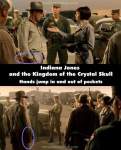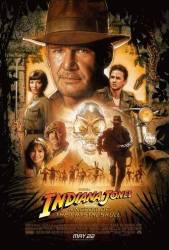
Continuity mistake: At the beginning when Indy is talking to Spalko, his hands keep alternating from being in his pockets to just resting at his sides between shots.

Directed by: Steven Spielberg
Starring: Harrison Ford, Cate Blanchett, Jim Broadbent, John Hurt, Ray Winstone, Shia LaBeouf, Karen Allen

Continuity mistake: At the beginning when Indy is talking to Spalko, his hands keep alternating from being in his pockets to just resting at his sides between shots.
Factual error: In the warehouse scene, the lights and other metal objects are affected by the box's magnetic field. Yet the soldiers easily lift the box into a metal truck to load it and slide it forward. If the box's magnetic field was as strong as suggested, it would have dragged the soldiers forward as it was magnetically attracted to the truck, and it would have taken much more effort for them to slide it onto the truck bed once it was stuck there.
Visible crew/equipment: When Dr. Irina Spalko is descending the cliff, you can briefly see the harness cable that is holding her up right next to the rope on which she is climbing down.
Trivia: In the Mayan temple, Indy comments "I have a bad feeling about this." This line was a running gag in George Lucas' Star Wars saga, and was used by Harrison Ford at least once. (01:46:10)
Trivia: When in the tent and forced to face the Crystal Skull, Indy dismisses the skulls as being from "Saucer Men From Mars". Indiana Jones and the Saucermen from Mars was actually an early title for the film.
Dean Charles Stanforth: We seem to have reached the age where life stops giving us things and starts taking them away.
Indiana Jones: Put your hands down, will ya? You're embarrassing us.
Marion Ravenwood: I'm sure I wasn't the only one to go on with my life. There must have been plenty of women for you over the years.
Indiana Jones: There were a few. But they all had the same problem.
Marion Ravenwood: Yeah, what's that?
Indiana Jones: They weren't you, honey.
Question: Why did the nuke fridge scene cause so much controversy?
Answer: Another problem is that people couldn't articulate what they didn't like about the film, and point to the "Nuke the Fridge" scene as a quick example of what they think is bad about it. In the realm of Indy, it's really no more outlandish than jumping out of a plane in an inflatable raft like in Temple of Doom.
It's considerably more outlandish. The raft scene was recreated/reviewed by Mythbusters, and they found that the raft floated down at a mere 22 mph. It would be hard/impossible in real life to stay on the raft, sure, but if you buy that bit of movie cheekiness, it would definitely slow their descent enough to survive, especially since they land a) on a slope and b) on soft snow. The fridge scene, however, has no such saving grace... it's completely ridiculous and unrealistic in every detail.
Question: Perhaps I've forgotten some details from The Last Crusade in the years since I've seen it, but shouldn't Henry Sr. not be dead in this movie, because he drank from the Holy Grail which gives immortality?
Answer: Yep, you've forgotten some details. The Knight specifically states that the immortality bestowed by the Grail is limited to those who remain within the shrine. Jones Snr left the cave, ergo, no immortality.
Separate from membership, this is to get updates about mistakes in recent releases. Addresses are not passed on to any third party, and are used solely for direct communication from this site. You can unsubscribe at any time.
Check out the mistake & trivia books, on Kindle and in paperback.
Answer: People felt it was ridiculous and cartoonish, even by Indiana Jones standards. Even if it was possible to survive a nuclear blast via the lead lining of a fridge (it's not), or that the fridge would simply be thrown away rather than be melted/torn apart like everything else in the vicinity (it wouldn't), the impact of being flung what appears to be a mile or so through the air, then violently crashing into and rolling over the ground, would certainly kill anything inside. The controversy arose because usually, in "classic" Indy films, the fantastical elements were exactly that: fantastic, magical, and/or supernatural. This was presented as taking place in our reality, with no "power of God" or magic spells, and for many, that was just too much disbelief to suspend.